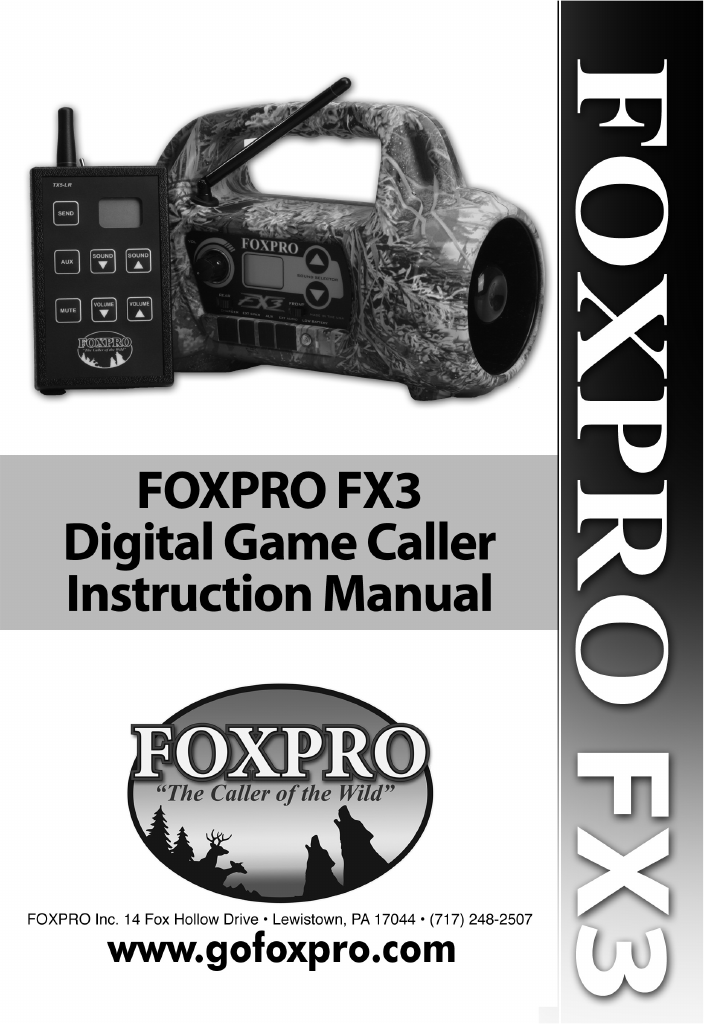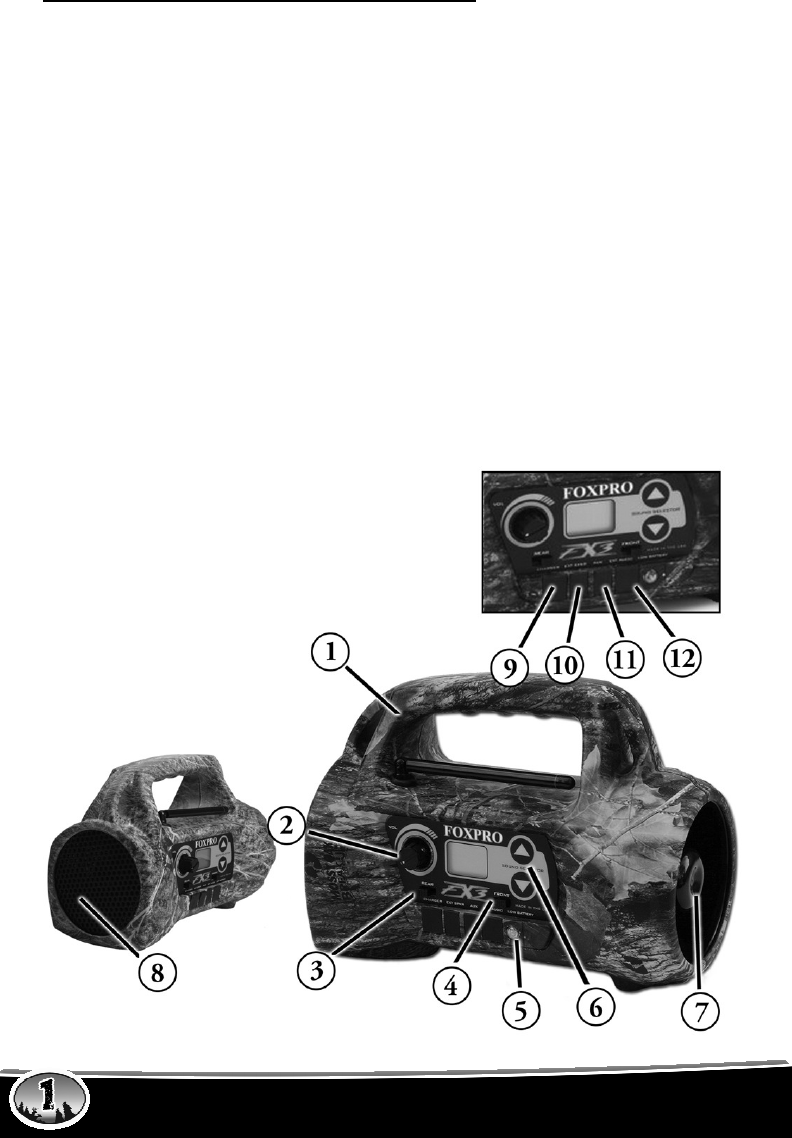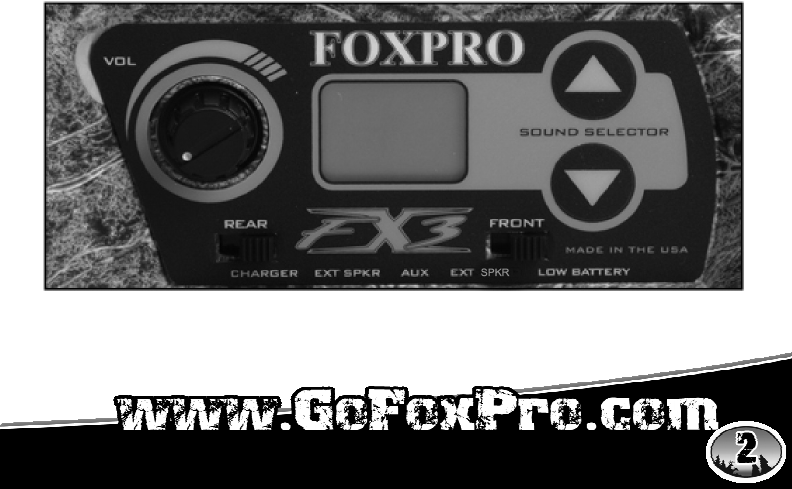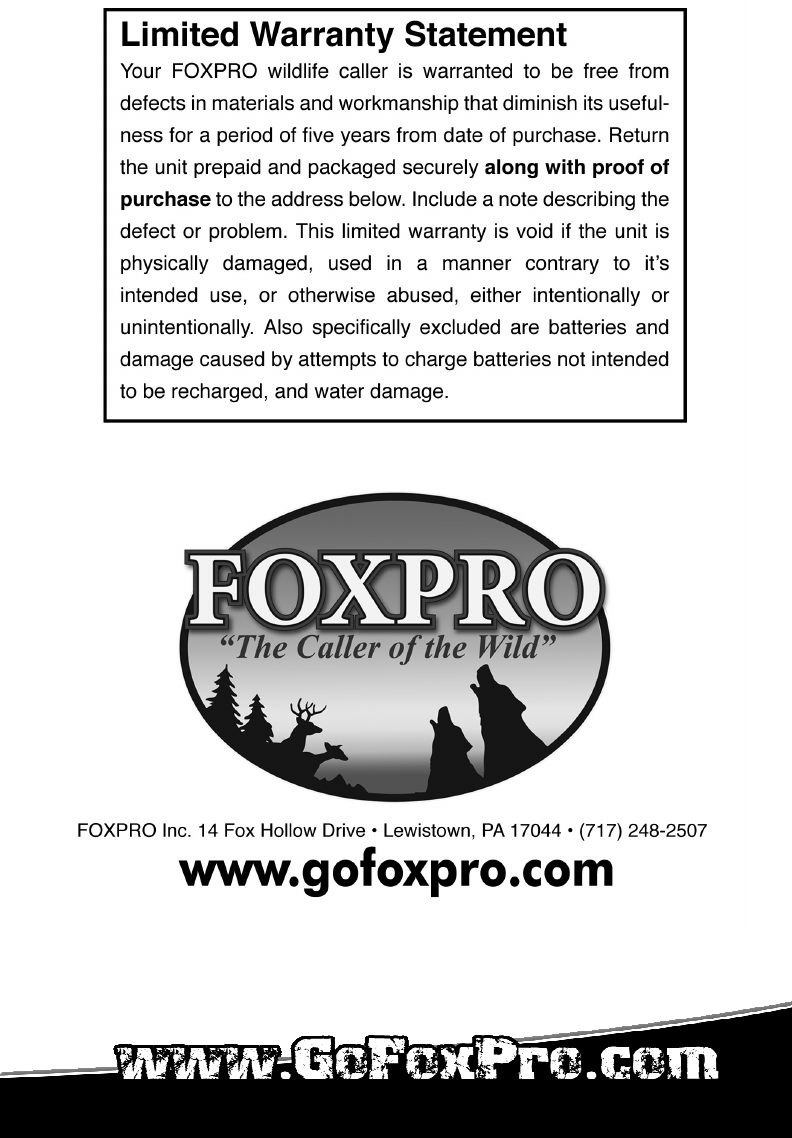Users Manual


TOPIC
PAGE
Using the FOXPRO FX3 Digital Game Call
1
Quick Operating Guide
2
About the FX3 Speakers
3
Batteries and Charging
4
Auxiliary Jack Function
5
Using the Remote Control
6
Reprogramming Sounds
6
Online Programming Support Center
6
Downloading the FOXPRO Programming Utility
7
Programming Your FOXPRO FX3
10
Printing a Sound List
1
0
Maximizing Remote Control Range
1
1

Important Information
FOXPRO’s goal is to provide our customers with the highest quality products in
the industry. We take great pride in manufacturing our products in the USA.
Please do not hesitate to contact us for assistance, comments or questions.
FOXPRO Inc.
14 Fox Hollow Drive
Lewistown, PA 17044
(717) 248-2507
Fax: (717) 247-3594
Hours of Operation
Monday – Friday
8AM – 5PM EST
Contact Us
Customer Service: (717) 248-2507
Toll Free Orders Only: 866-463-6977
General Inquiry E-mail: sales@gofoxpro.com
Stay up to date with the latest sounds by visiting our online sound library.
Watch for new products and upgrades from FOXPRO. Visit us online:
www.gofoxpro.com

Using the FOXPRO FX3 Digital Game Call
Congratulations on the purchase of your FOXPRO FX3 digital wildlife caller!
You have chosen a highly advanced product with reliability, ease-of-use, and
features that are second to none. The FX3 is the product of an engineering
effort that spanned several years. Please take this time to read and understand
the information in this instruction booklet. This will ensure that you receive the
maximum benefit from your new FOXPRO FX3.
Features
1. Rugged injection molded ABS housing
2. On/Off switch-manual volume control
3. Rear Speaker Slide Switch
4. Front Speaker Slide Switch
5. Low Battery Indicator LED
6. Sound Up/Down Keys
7. Reflex Horn Speaker
8. Rear Cone Speaker
9. Charger Jack
10. Rear Ext Speaker Jack
11. Auxiliary Jack
12. Front Ext. Speaker Jack

QUICK OPERATING GUIDE
Since the FX3 is shipped from the factory with no batteries installed, the first
step is to install 8 “AA” batteries. These may be alkaline or rechargeable
types. We strongly recommend high capacity NiMH rechargeable batteries over
alkaline types for maximum performance, particularly when using loud volume
levels.
Installing Batteries in the FX3
1. To install batteries, remove the battery door. The battery door is
located on the side of the caller, and is held in place with a knurled
thumbscrew.
2. Orient the batteries as per the directions shown in each cavity within
the holder.
NOTE: The battery polarity alternates.
3. Replace the battery door after the batteries are installed.
Installing Batteries in the TX5-LRB
The TX5-LRB transmitter operates from a 9V battery. Please use a high quality
alkaline battery.
1. Remove the battery compartment cover located on the rear of the
transmitter.
2. Connect the 9V battery to the connector plug, and orient the battery in
the transmitter.
3. Replace the battery compartment cover.
Playing Sounds Manually
1. Make sure that at least 1 of the speaker selector slide switches is set to
the right, or “ON” position.

2. Click the On/Off/Volume switch to the on position. Please note that this
switch is also the volume control when the unit is operated without the
remote control. The further clockwise you turn the knob, the louder the
unit will play. At this point, the LCD display on the FX3 will be flashing
“- -“.
3. Press the up or down arrow keypad button on the FX3 to select a
sound number. Once selected, release the button, and the sound will
play. To select a different sound, simply press the up or down arrow
buttons again to your desired sound. Please note that by pressing and
holding either the up or down keys the numbers will ramp slowly at first,
and then increase to a faster ramp speed.
Playing Sounds with the TX5-LRB Remote Control
1. Turn on the TX5-LRB transmitter by pushing any of its keys. Choose
the sound number to be played by using the transmitter sound up or
down buttons.
2. When the chosen number is shown in the transmitter display, push the
“SEND” button.
NOTE: Although the FX3 enters remote mode un-muted, no sound will be
heard because volume is preset to minimum.
3. To adjust the volume, press and hold the “VOLUME UP” key on the
transmitter. Release the key when the volume reaches a suitable level.
If no sound is heard you may have inadvertently pushed the “MUTE”
button. Note that the mute function is latching. That is, the first button
push will mute or pause the sound and the next will allow the sound to
play. The “MUTE” will cause the sound to pause in addition to muting it.
Use the “AUX” button to activate a device such as a decoy or camera
connected to the FX3 “AUX” connector. Remember to turn the volume
control to “OFF” when you are finished using the caller. “MUTE” is not
“OFF.” Some battery drain continues in “MUTE” mode.
ABOUT THE SPEAKERS
This caller incorporates 2 different types of loudspeakers. The front speaker is
a high efficiency horn with maximum sensitivity in the frequency range
necessary to reproduce small animal distress sounds. Distress sounds of
rabbits, small rodents, birds, canines, and many others are best reproduced by
using the front horn only with the rear cone speaker turned off. This will also
ensure maximum battery life as playing both speakers requires almost twice as
much battery power.
The rear cone speaker is best suited to sounds that have significant lower
frequency content. These sounds would include bear growls, mountain lion
roars, certain owl hoots and some other large mammal sounds. The rear
speaker, however, is not as efficient as the front horn. Because of this, it will

not play as loud as the horn. Understand that not all calling sounds will benefit
greatly from playing both speakers at once. If you elect to do this, remember
that battery life will be reduced.
BATTERIES AND CHARGING
Your FX3 operates on 8 “AA” batteries. For optimal performance and run times,
we recommend high capacity 2500 mAh NiMH (Nickel Metal Hydride)
rechargeable cells rather than alkaline types.
NOTE: Remove batteries from battery holder when caller will not be used for
prolonged periods to help prevent deep discharge.
When you ask your FX3 caller to play at extremely loud volume levels, the
current demand on the batteries is much more than alkaline cells can deliver.
Consequently, the run time of these batteries can be very short. The Zinc
Carbon so-called “Heavy Duty” cells are expressly NOT recommended at all.
The performance of your FX3 will be much better with high capacity NiMH
batteries.
Installing Batteries
1. Remove the battery door which is located on the side of the caller. The
battery holder is located beneath this door. Be careful to observe
battery polarity! Note that the cell polarity alternates. Batteries may be
damaged if installed backwards. Double-check polarity before
reinstalling the battery door. NiMH batteries should be charged before
first use.
CAUTION: Never attempt to charge batteries that are not intended to be
recharged! This includes both Zinc Carbon and alkaline cells. The resulting
damage can be serious, and will not be covered by the warranty.
For maximum charge efficiency, we recommend charging your FX3 in
temperatures ranging from 40°F to 85°F (5°C to 30°C).
To charge the batteries, connect the FOXPRO FX Series charger to the FX3
charge jack. Be aware that the green LED may or may not extinguish when the
batteries are fully charged. Your FOXPRO unit incorporates circuitry to
terminate charge current if high battery temperatures are detected. Battery
temperatures increase at the end of the charge cycle. If the temperature edges
towards a dangerous level, the charge current will be interrupted and the green
LED will extinguish. If excessive temperature is not detected, the green LED
will not be extinguished. It is quite possible for the batteries to be fully charged

without their temperature rising to the dangerous level. For this reason, the
LED should not be considered as a “full charge” indicator as it may or may not
extinguish when the batteries are fully charged. The batteries are fully charged
any time their temperature rises substantially above ambient. How long this
takes depends on how much charge has been taken from the batteries and
how much time has passed since the last charge. If the green LED goes out,
the batteries are definitely charged. If the green LED is on and the batteries are
cool, they are still charging. If the green LED is on and the batteries are very
warm, they are fully charged and you should terminate the charge by
unplugging the charger. You should not permit the charge to continue for
more than 12 hours under any circumstances. The batteries need to be
recharged when the “Low Battery” LED is blinking while the FX3 is in use. If this
warning is ignored, the FX3 will abruptly shut off and display “LO” on the LCD
display. Battery run time is directly related to how loud you operate the FX3.
Using both speakers at the same time rather than only the most appropriate
one will have a negative impact on run time. With one speaker playing, expect
6 to 15 hours of run time, depending on the loudness setting. With both
speakers playing, expect 3 to 10 hours. Remember that very loud volumes are
rarely needed, as animals hear much better than we do.
“AUX” JACK FUNCTION
The FX3 is equipped with an auxiliary jack labeled “AUX”. The purpose of this
jack is to allow for the connection of certain external devices, such as the
FOXPRO Jack-in-the-Box Decoy, and to be able to turn these on and off with
the TX5-LRB remote control transmitter. However, there are some strict
electrical limits involved with this jack. If these limits are exceeded, damage to
your FX3 will result. This damage is not covered by the warranty.
The electrically inclined will want to know that the jack is connected to the drain
of an internal Field Effect Transistor with a maximum current rating of 2
Amperes. The “tip” polarity of the 3.5mm jack is positive, while the sleeve is
negative. If the external device is connected with the polarity reversed, an
internal protection diode within the FET will conduct, causing the device to stay
on constantly. The maximum voltage applied to this jack must never exceed 15
volts. Typical uses for this jack would be to control the FOXPRO Jack-in-the-
Box Decoy, or to start and stop a video recorder. Instructions on connecting
various devices to the “AUX” jack are beyond the scope of this manual. You are
urged to seek help from a knowledgeable professional before connecting any
unapproved device to this jack. Remember that damage to your FX3 caused by
improper use of the “AUX” jack is not covered by the warranty, nor will
FOXPRO be liable for damage to any device connected to this jack. Typical
uses for this jack would be to control the FOXPRO Jack-in-the-Box Decoy, or to
start and stop a video recorder.

USING THE REMOTE CONTROL
Note that there is no “local-remote” switch to flip. Each time the FX3 is turned
on, it enters the manual mode. While in this mode, you can adjust the volume
with the volume control, and change sounds with the sound select buttons on
the keypad. To switch to remote control mode, simply push any button on the
TX5-LRB transmitter. The FX3 will auto-detect the remote control mode and
silence any sound that may be playing. Once the FX3 has entered the remote
mode, its volume control and sound selector buttons are disabled. From this
point on you must use the TX5-LRB transmitter to control the caller. Select the
sound to be played using the TX5-LRB sound selector buttons, then press the
“SEND” button. Although the FX3 enters remote mode un-muted, no sound
will be heard because the volume is preset to minimum. Now push and
hold the volume up button on the transmitter until the volume reaches a
suitable level. Each time you select a different sound, you must press the
“SEND” button to make that sound play. Pushing the “MUTE” button will silence
the speakers and cause the sound to pause. A second “MUTE” button push will
restore the sound.
REPROGRAMMING SOUNDS ON YOUR FX3
The FX3 comes standard with a USB 2.0 port built in (no reader/writer is
necessary), which makes reprogramming or adding sounds to your FX3 easier
than ever. A computer is required in order to reprogram your sounds. The FX3
can be reprogrammed by using personal computers equipped with Windows
operating system version 98SE or later or a Macintosh computer with an
operating system of 9.X or later.
FOXPRO’s Online Programming Support Center
The Programming Support Center features highly detailed written instructions
for programming your FX3 along with a video tutorial that will guide you through
the entire process. Please visit the following website for more information:
http://www.gofoxpro.com/program.php
NOTE: If operating from Windows Version 98SE, you will need to download a
driver that will allow your operating system to work with your FX3. This driver is
available at no charge from our website, www.gofoxpro.com, under Programs /
Utilities, and is called “Windows 98 SE USB Utility Driver”. If you do not have
access to a computer, sounds can be reprogrammed or added for a fee by
sending your FX3 to FOXPRO Inc.
Downloading the FOXPRO Programming Utility
We have developed a utility that simplifies the reprogramming of sounds on

your FX3. This utility is available for download at no charge from our website.
To download and install the Programming Utility from the website:
1. Go to www.gofoxpro.com
2. Click on Programs / Utilities.
3. Once there, double click on the FOXPRO Programming Utility.
4. Double click Download Now.
5. Select Save, and choose the location to store the .exe file. (We
recommend saving it to your Desktop).
NOTE: The name of the file on your Desktop (if you choose your Desktop
as the location to save) will be labelutil.exe.
6. Double click the labelutil.exe icon, and select Run. (This will begin the
installation process).
7. At the next screen, select OK.
8. Click on the button where prompted (the button is the one that
resembles a computer).
9. Click on the continue button. (This should complete the setup of
the FOXPRO Programming Utility).
NOTE: The icon on your desktop is only a .exe file used to install the
programming utility to your computer. Once you have completed the
installation of the program, this icon can be deleted. The actual program
will be in your program files on your computer, and is called FOXPRO
Programmer.
The Programming Utility is also stored on the FX3’s memory card.
To download and install the Programming Utility from your FX3
1. Connect your FX3 to your PC with the supplied USB cable (once the
FX3 is recognized by the PC it will be assigned a drive letter).
2. Enter your “MY COMPUTER” icon and locate the FX3 from the list of
available drive letters (once you have located the drive for the FX3,
double-click on the icon to open it up).
3. After the drive is opened, locate the file named labelutil.exe, and then
refer to above steps 6 through 9 for installation of the Programming
Utility.
Programming your FX3 with the FOXPRO Programming Utility
To gain access to the FX3’s USB port, which is on the side of the caller:
1. The battery door is located on the side of the caller, and is held in place
with a knurled thumbscrew
NOTE: The USB port is located in the upper left portion of the battery
compartment.
2. Connect the provided USB cable between this port, and the USB port
on your computer. (Once the connection is made, your computer
should recognize the FX3 as a removable drive).

3. Double click the folder on your desktop or go to your programs folder
and open the FOXPRO Programmer. (You will be prompted to make a
backup of your sounds).
4. Select OK, you will then be taken to the programming utility.
5. Select the proper USB drive for the FX3. (This is marked as Select
Device, located in the upper right portion of the programming utility).
NOTE: This drive varies on different computers. Once you have selected the
proper drive, the list of sounds currently on your FX3 will appear in the right
vertical window. You will now notice that a new button appears above the
Select Device window that reads “Backup”. If you have not made a backup of
your sounds, click on this button. The programmer by default will backup your
sounds to a “FOXPRO” folder, and a sub folder “Backup”. This is the best folder
to use to add new sounds prior to adding sounds, or reprogramming your FX3.
You can also create sub folders for different species, if you choose, rather than
to have all sounds located in one folder. Once your backup is complete, you
are ready to reprogram your FX3.
6. Select the “source” folder of your new sounds (located on the left hand
side of the programmer screen). This is the folder where your sounds
are located.
7. Double click on the C: \ prompt and locate the “FOXPRO” folder. (The
Sounds sub folder should show up, assuming that you have used this
folder to store your sounds). If this is not the folder that your sounds
are located in, select the proper folder.
8. Once the proper folder is selected, double click the folder. (The sounds
should now appear in the left side column, called “Source Sound
Files”). Now, determine the position that you would like to add new
sounds to your FX3. For example, if you would like to add the
Jackrabbit Distress to your FX3, highlight the sound in the left side
column.
NOTE: If this sound does not have a three digit number and a space
located at the beginning of it, you must check the Append Sound Number
box located below the left column. By selecting this box, the sound name
will not be shortened. If there is a three digit number and a space before
the name of the sound, there is no need to check this box. The first four
characters will be either truncated or ignored, by not selecting this box.
9. Select the position in the right column where you would like to add the
sound. If you want to overwrite the sound in that position, then click on
the overwrite box, located between the two columns. This will replace
the current sound in that position.

NOTE: The sound that was located in that position will be deleted. If you
choose to insert the sound in that position and move all other sounds down
one, click the insert button. This will add the sound in that position and not
overwrite the current sound. If you would like to remove sounds from the
right side column before adding new ones, simply highlight the sound, and
click on the “Remove from List” button, located between the two columns. If
you would like to relocate a sound in the right sound column, you can
highlight the sound and then type the position number that you would like
to move it to in the “Move To” box (located below the right side column).
This will move the sound to your designated number. You can also
highlight the sound that you wish to move on the right column, and then
click on the up or down arrows below the right side column to move the
sound one position at a time. If you would like to reset your list at any time,
click on the Clear/Reset List button, located on the right side of the screen.
This will reset the list to its initial sounds.
10. Click on the “Copy to Caller” button located on the right side of the
screen. Your sounds will now be programmed to your FX3.
IMPORTANT NOTE: Your FX3 will play .FXP, .mp3 and .wav files (stereo .wav
files at 32 kHz sample rate). Other file types are not supported. Although you
may store .FXP sounds on your computer for later use, they cannot be played
on your computer, or on any audio player other than a FOXPRO caller.
Printing a Sound List
With the FOXPRO Programming Utility Opened:
1. Connect the FX3 to your computer using the provided USB cable (the
FX3 must be attached to your computer and the USB port on the
caller).
2. Select the drive letter for the FX3 (this will display all of the sounds in
the Caller Sound File Column).
NOTE: Be sure that your printer is turned on.
3. Click the button labeled “PRINT LISTS.” Your new sound list will then
be sent to your printer.
UPLOADING SOUNDLIST TO OPTIONAL TX-24 REMOTE CONTROL
Program your sounds into the FX3 as outlined in the instruction manual. Make
certain that you do not use the same number for more than one sound! Note
that the transmitter can only display 21 characters per line. The first 3
characters must be the sound number, from “000” through “023”. Place a space
between the sound number and the sound name. 17 characters remain for the
sound name. Although the sound name can have more characters, the TX-24
will only display the first 17 characters. Any additional ones will not be
displayed.

1) Disconnect all accessories from the FX3 (i.e. speakers or decoy)
2) Turn the power off on both the FX3 and the TX-24.
3) Connect patch cable from the sound upload jack on the TX-24 to the
AUX jack on the FX3.
4) Turn on the TX-24
5) After being powered on, the TX-24 display will say “Turn On Caller”
6) Power on the FX3
7) The display on the TX-24 will scroll through all 24 sounds. When it’s
done, the display will say “Transfer Complete”
8) Unplug the cable from both ends.
9) Turn off the TX-24 and the FX3.
10) Turn on your TX-24 and your new sounds will be
displayed.
NOTE: This process may take a few minutes. DO NOT
turn off the TX-24 or FX3 during this process.
MAXIMIZING YOUR REMOTE CONTROL RANGE
Your FX3 includes FOXPRO’s long range TX5-LRB remote control. In order to
maximize your remote control range, here are a few tips that you should follow:
1. Elevate your FX3. This step is the most important one to follow to
maximize the range of your remote control. If your unit is raised off of
the ground, the signal strength received by your FX3 will be
maximized. In general, more elevation will yield better performance.
Try setting your unit on a stump, fencepost or hang it from a tree limb,
where possible.
2. Keep all antennas vertical. When setting up your FX3, be sure to raise
the antenna to the vertical position and when operating your TX5-LRB,
hold the transmitter with the antenna in a vertical position. Do not point
the antenna toward the FX3.
3. Have a clear line of sight to the FX3. Foliage and other objects
between the transmitter and the FX3 can greatly decrease the remote
range.
4. Keep the transmitter away from your body, guns and shooting sticks.
These objects can absorb energy from the transmitter and can detune
the antenna, which will decrease transmitter strength.
NOTE: Failure to follow these tips will decrease performance of your remote
control. Also, please be aware that even if all of the above tips are followed, it is
possible that the performance of your remote control could be limited in certain
areas due to factors beyond our control, such as proximity
to noisy power lines,
two way radio transmitter sites and other areas of high RF energy.

FCC Information
NOTE: This equipment has been tested and found to comply with the limits for a Class
B digital device, pursuant to Part 15 of the FCC Rules. These limits are designed to
provide reasonable protection against harmful interference in a residential installation.
This equipment generates uses and can radiate radio frequency energy and, if not
installed and used in accordance with the instructions, may cause harmful interference
to radio communications. However, there is no guarantee that the interference will not
occur in a particular installation. If this equipment does cause harmful interference to
radio or television reception, which can be determined by turning the equipment off and
on, the user is encouraged to correct the interference by one or more of the following
measures:
• Reorient or relocate the receiving antenna.
• Increase the separation between the equipment and receiver.
• Connect the equipment into an outlet or circuit different that to which the
receiver is connected.
• Consult the dealer or an experienced radio/TV technician for help.
Operation is subject to the following two conditions: (1) this device may not cause
interference, and (2) this device must accept any interference, including interference
that may cause undesired operation of this device.
Modifications not expressly approved by the manufacturer could void the user’s
authority to operate the equipment under FCC rules.
Industry Canada Notice
Operation is subject to the following two conditions:
This device may not cause harmful interference and
This device must accept any interference received, including interference that may
cause undesired operation.
